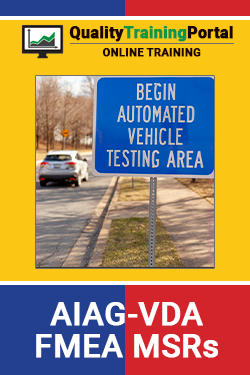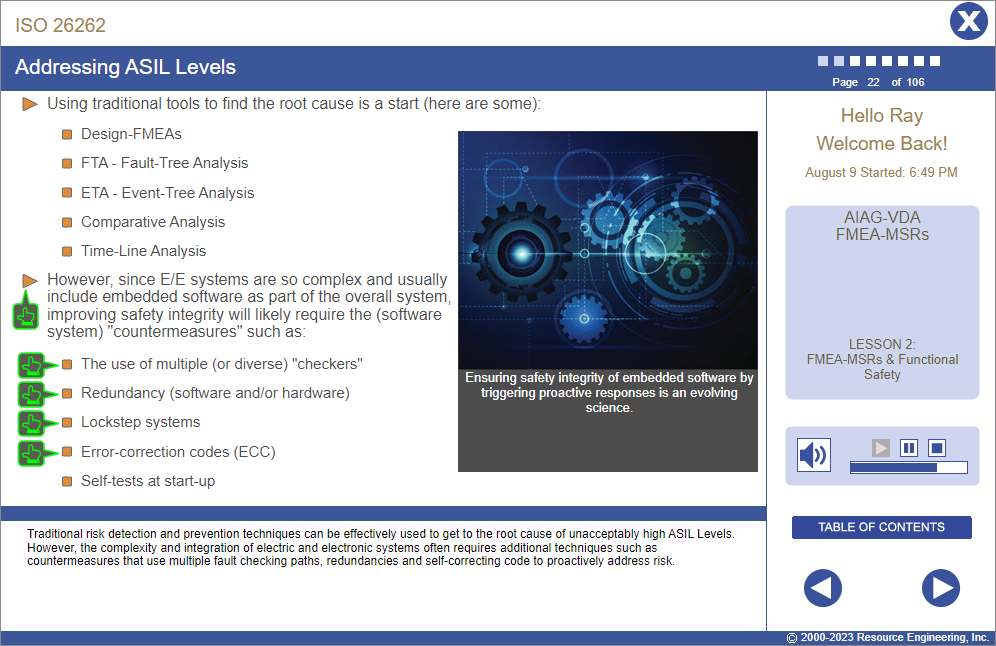Course Information
AIAG-VDA FMEA-MSRs Training
Learners will be able to:
- Describe the link between FMEA-MSRs and DFMEAs.
- Participate on an FMEA-MSR team.
- Use MSR results to reduce risk.

About This Course
Failure Mode and Effects Analysis (FMEA) techniques have been used for over 70 (yes, SEVENTY!) years. In recent years, use of FMEAs has gained popularity as a quality improvement tool. Most industries are now using FMEA techniques as part of their risk assessment and risk mitigation strategies. Unlike many quality improvement tools, FMEAs do not require complicated statistics. FMEA studies can yield significant savings for a company as well as reduce potential risks and associated liabilities of a product or process that does not perform as intended.
In 2019, AIAG (Automotive Industry Action Group, www.aiag.org) and VDA (Verband der Automobilindustrie, www.vda.de), two of the leading automotive trade associations, unveiled a major revision to FMEA methodology with the release of the AIAG-VDA FMEA Handbook.
This online training prepares learners to participate on the core team of an Supplemental FMEA for Monitoring and System Response (FMEA-MSR) using the 2019 AIAG-VDA FMEA Handbook. The course provides a background understanding of FMEAs, provides detailed instruction for participating on an FMEA-MSR Core Team and shows how DFMEAs and FMEA-MSRs are linked.
IMPORTANT NOTE: While the AIAG-VDA FMEA-MSRs course is in line with the AIAG-VDA FMEA Handbook, it is not intended as a replacement for the source Handbook. We recommend that this course be used in conjunction with the official Handbook.
- AIAG-VDA Design FMEAs Training or equivalent.
- English (EN-US)
- Chinese (simplified) (ZH)
- Czech (CS)
- French (FR)
- German (DE)
- Italian (IT)
- Japanese (no audio) (JA)
- Korean (no audio) (KO)
- Polish (PL)
- Portuguese (Brazilian) (PT-BR)
- Romanian RO)
- Russian (RU)
- Spanish (ES)
- Vietnamese (no audio) (VI)
Course Objectives
- Explain the purpose of conducting an FMEA-MSR and how it is related to a DFMEA.
- Explain the methodology of the AIAG-VDA FMEA-MSR process.
- Use the 5 T’s to plan and prepare for an FMEA-MSR study.
- Work though each step of the 7 steps for conducting an FMEA-MSR.
- Use the FMEA-MSR Analysis Worksheet to document the results of the study.
- Customize the Severity, Frequency and Monitoring/System-Response Ranking Scales.
- Use the results of an FMEA-MSR to continue to reduce risk.
Course Outline
Lesson 1 | Why Conduct FMEA-MSRs and How They Fit with DFMEAs
- To understand when FMEA-MSRs are used.
- To know how FMEA-MSRs supplement DFMEAs.
- To be aware of major differences between DFMEA and FMEA-MSR methodologies.
Lesson 2 | Overview of the FMEA-MSR Process
- To understand the role Functional Safety plays in conducting FMEA-MSRs.
- To be familiar with the generic standard on Functional Safety, IEC 61508, and the automotive version, ISO 26262.
- To realize how Automotive Safety Integrity Levels (ASIL) are used to evaluate risk profiles and hazards.
- To gain an appreciation for the use of “countermeasures” to address hazards and improve safety integrity in E/E systems that use embedded software.
Lesson 3 | System Analysis (Steps 1, 2 & 3)
- To appreciate how to charter and start-up an FMEA-MSR team.
- To understand how to analyze the structure of the design under study.
- To learn how to identify the (monitoring and response) functions of each design component
Lesson 4 | Failure Analysis and Risk Mitigation (Steps 4, 5 & 6)
- To understand the concept of a Failure Chain.
- To use the Failure Chain model to identify failure modes, failure effects and failure causes for each design element.
- To realize how to use Evaluation Criteria to rate the Severity, Frequency and Monitoring for each failure.
- To understand how to create custom Evaluation Criteria.
- To learn how to use the FMEA-MSR Action Priority Tables to assign AP Levels.
Lesson 5 | Communication (Step 7)
- To know how to document and communicate FMEA-MSR results.
Lesson 6 | Helpful Tips
- To be aware of some techniques and approaches that can help teams conduct FMEA-MSRs more effectively and efficiently
Challenge
- An assessment of the learner’s progress in this course.

4.4 out of 5 stars
Comments from Learners About This Course
- Very well put together and in a way that can be logically followed.
- Very interesting topics, will be help us to reduce potential failures on the new products and increase our design confidence.
- It was a thought provoking course and test.
- Great, thorough training.
You may also be interested in…
- Mistake-Proofing Training – Comprehensive online training in poka yoke/mistake-proofing techniques for manufacturing operations.
- 8D Problem-Solving – Step-by-step training in how to work on a problem-solving team follow the 8D methodology including tools and techniques that are used in each step.
- Root Cause Analysis with Corrective Action – Leads the learner through a four-step process to get to the root cause (source) of problems to eliminated problems for good.





